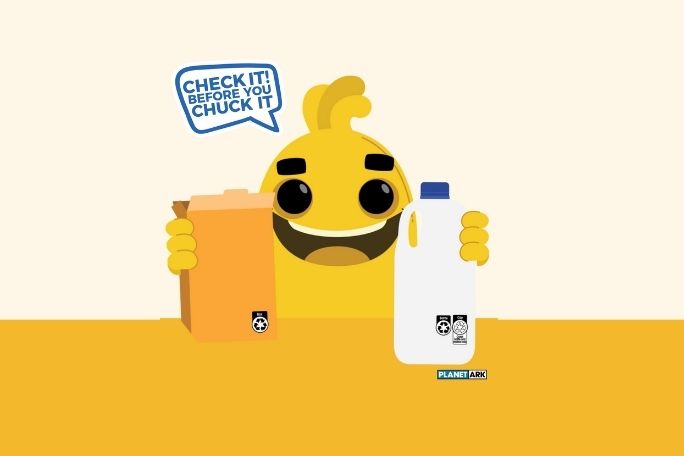Lesson summary
Whenever there is packaging there is a purpose.
It can be easy to demonise the amount of packaging we consume – or, really, dispose of heedlessly. But packaging usually has a good purpose in mind: it protects its precious contents and makes things easier to transport. Sometimes it may be the way we use packaging for its convenience that is unsustainable. Do we really need another laundry powder scoop or an unpeeled mandarin in a container? Could we rethink and redesign packaging so that it remains fit for purpose but is more sustainable?
In this lesson students undertake real-world learning in the role of material designers. They investigate a range of packaging items and discuss why some of these items don’t feature the Australasian Recycling Label (ARL). They research the barriers to meeting ARL classifications and consider the benefits and challenges of using certain materials for certain packaging before attempting to redesign a product to meet ARL classifications.
Learning intentions:
Students will...
- understand the competing needs of packaging.
Success criteria:
Students can...
- identify the purpose of packaging
- critically evaluate the purpose and sustainability of packaging
- think critically and creatively to redesign packaging.
Lesson guides and printables
Lesson details
Curriculum mapping
Australian Curriculum content descriptions:
Year 5 & 6 Design and Technologies:
- Generate, develop and communicate design ideas and processes for audiences using appropriate technical terms and graphical representation techniques (ACTDEP025)
- Negotiate criteria for success that include sustainability to evaluate design ideas, processes and solutions (ACTDEP027)
- Develop project plans that include consideration of resources when making designed solutions individually and collaboratively (ACTDEP028)
Year 5 Science:
- Scientific knowledge is used to solve problems and inform personal and community decisions (ACSHE100)
Year 6 Science:
- Scientific knowledge is used to solve problems and inform personal and community decisions (ACSHE083)
Syllabus outcomes: ST3-5WT, ST3-7PW
General capabilities: Literacy, Information and Communication Technology (ICT) Capability, Critical and Creative Thinking, Personal and Social Capability, Ethical Understanding
Cross-curriculum priority: Sustainability
Relevant parts of Year 5 & 6 Design and Technologies achievement standards: Students describe competing considerations in the design of products, services and environments, taking into account sustainability. They describe how design and technologies contribute to meeting present and future needs. Students explain how the features of technologies impact on designed solutions for each of the prescribed technologies contexts. Students create designed solutions for each of the prescribed technologies contexts suitable for identified needs or opportunities. They suggest criteria for success, including sustainability considerations, and use these to evaluate their ideas and designed solutions. They combine design ideas and communicate these to audiences using graphical representation techniques and technical terms. Students record project plans including production processes. They select and use appropriate technologies and techniques correctly and safely to produce designed solutions.
Relevant parts of Year 5 Science achievement standards: Students discuss how scientific developments have affected people’s lives, help us solve problems and how science knowledge develops from many people’s contributions.
Relevant parts of Year 6 Science achievement standards: Students explain how scientific knowledge helps us to solve problems and inform decisions and identify historical contributions
This lesson is part of the wider unit of work Australasian Recycling Label
Time required: 60 mins
Level of teacher scaffolding: High – students will require support in discussing concepts of recyclable packaging and significant scaffolding when attempting to redesign a piece of packaging
Resources required
- A range of packaging that vary in colour, weight, shape and texture. These could include a small plastic tub, a plastic bottle, a milk carton, a paper bag, etc. Make sure all items are clean and sharp edges are covered with masking tape.
- A device capable of presenting a video to the class
- Individual devices capable of accessing the internet – one per student
- The PREP fact sheet (https://recyclingnearyou.com.au/documents/doc-1977-prep-fact-sheet.pdf)
Skills
This lesson is designed to build students’ competencies in the following skills:
- Communication
- Creativity
- Critical thinking
- Digital literacy
- Enterprise
- Ethical understanding
- Global citizenship
- Initiative
- Problem solving
- Social skills
- Collaboration
Additional info
This lesson has been developed as part of Planet Ark’s campaign around the Australasian Recycling Label and sustainable packaging. You can get involved during Planet Ark’s National Recycling Week or at any time during the school year and join thousands of amazing teachers in making a difference and creating positive environmental change. If you use any of these lessons, we highly recommend you submit an entry for the School’s Recycle Right Challenge in Term 4 and enter in the draw to win amazing prizes for your school!


Welcome back!
Don't have an account yet?
Log in with:
By signing up to Cool.org you consent and agree to Cool's privacy policy to
store, manage and process your personal information. To read more, please see
our privacy policy here(Opens in new tab).
Create your free Cool.org account.
Many of our resources are free, with an option to upgrade to Cool+ for premium content.
Already have an account?
Sign up with:
By signing up to Cool.org you consent and agree to Cool's privacy policy to
store, manage and process your personal information. To read more, please see
our privacy policy here(Opens in new tab).